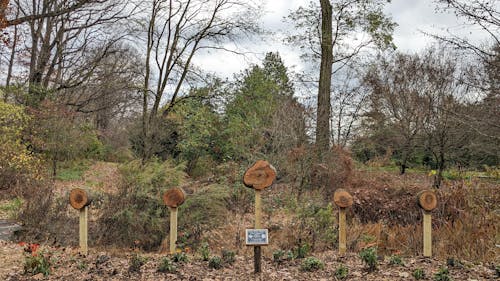Local Boy Scouts install new bee houses, pollinator plants in Rutgers Gardens

On October 12, members of Old Bridge Boy Scouts Troop 219 helped plant flowers and place bee houses made out of recycled materials at Rutgers Gardens, according to an Instagram post.
Lauren Errickson, director of Rutgers Gardens and Campus Stewardship, said Rutgers Gardens is the University’s official botanical garden and houses many different species of plants in various gardens. The area is open to everyone to enjoy and is also free of charge to visit, she said.
The nearly 180 acres of space at the gardens, which include the Holly Collection, Rain Garden and Pollinator Garden, is preserved partially by the work of volunteers.
Errickson said that the Pollinator Garden specifically features species that provide habitats, pollen and nectar to bees and other pollinators, which is of the utmost importance for the maintenance of ecosystems and agriculture.
"With much of the natural habitat in New Jersey having been lost to development over the years, designating and preserving areas that support native species of plants and insects is increasingly important," she said.
This particular project was proposed by Jeffrey Matthews, an aspiring Eagle Scout in Troop 219, who was interested in helping restore the bee population due to its rapid decline over the past several years.
While Troop 219 regularly gives back to the community through town cleanups and other service projects, Matthews chose to tackle a project that would provide an environmental benefit.
He began brainstorming in May and eventually decided to build bee habitats and plant flowers around the habitats’ exteriors. In doing so, the bees would have both an area to live and pollinate, he said.
After coming up with the idea, Matthews started to look for a host site for his project and ultimately landed on Rutgers Gardens.
He said that the construction of five bee houses was completed without issues prior to the actual installation date in October.
Other aspects of the project’s execution, though, like obtaining and maintaining flowers in chilly fall weather conditions, proved difficult as they had to prevent them from freezing, he said.
From start to finish, the project only took 4 hours' worth of on-site work with the help of approximately 30 other volunteers, he said.
Matthews said that he has plans to visit Rutgers Gardens in the springtime to see the progress of his project when the flowers are in season and the bees are more active.
His project will ultimately have positive implications beyond the immediate future, especially due to the inclusion of plants that will enhance the new bee habitats, Errickson said.
The plants, aside from providing nectar and pollen for the nesting bees, will also supply seeds in upcoming seasons for birds to eat, like the purple coneflower. The plants will also enrich the soil of the local environment, like the blue false indigo, through nitrogen fixation.
As perennials, the plants will sprout yearly and develop roots that will reduce soil erosion. The volunteers’ addition of woodchip mulch to the plant beds will also increase the organic matter found in the soil, Errickson said.
In addition, the efforts of volunteers enable garden spaces to be installed and maintained, invasive species to be weeded and seeds to spread in preparation for future events, she said.
"Participating in volunteer service projects gives people the chance to become a part of the story of Rutgers Gardens, which has a long history with the university and the community," Errickson said. "It’s an opportunity for volunteers to know that their efforts are contributing to a lasting legacy with a meaningful impact on the local ecosystem and the community as a whole."



